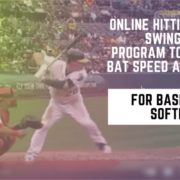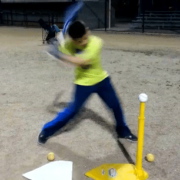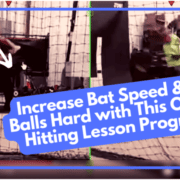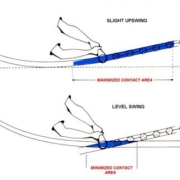Online Hitting Lessons Swing Analysis Increase Bat Speed And Power Program For Baseball & Softball
Discover this online hitting lessons swing analysis program to increase bat speed and power for the baseball and softball swing.
The Sooner You Use These Baseball Exercises the Better
I was working on a feedback session with one of my online lessons Austin, from SoCal, the other day…
And I realized that yes, most of the time, fixes are swing specific, but other times…
It can be suggesting a corrective exercise to help stabilize the core better during the swing. In this post, I’m going to walk you through:
- The late torso “tip”, and then
- How to correct it with two simple baseball exercises…
The Late Torso “Tip”
Watch the quick analysis video above…
Basically it’s a late tipping of the torso towards the plate, at the waist. This can cause the head to lay parallel to the ground obstructing vision. Sometimes, the back shoulder and ear get closer to together (like Derek Jeter), which breaks, what Dr. Kelly Starrett calls, spinal integrity, and will bleed force at impact.
This can be caused by a dysfunctional Quadratus Lumborum (or QL). And, according to Thomas Myers of Anatomy Trains, an imbalanced Lateral Fascial Line.
How To Correct it with Two Simple Baseball Exercises
Here are the two exercises to help with lateral core stabilization during the Final Turn:
- Side Plank (specific) – or CLICK HERE to view a side plank laying on the forearm (if you have wrist issues).
- One-Sided Farmer’s Walk (integrated).
Here’s what the acute variables look like (for both baseball exercises)…
- Week-ONE: 2 sets X 45 secs ea. side,
- Week-TWO: 2 sets X 60 secs each side,
- Week-THREE: 3 sets X 45 secs ea. side, and
- Week-FOUR: 3 sets X 60 secs ea side.
Do these baseball exercises horizontally. In other words, do a set of side planks (both sides), followed by a set of one-sided farmer’s walks (both sides). Rest 60-seconds, then move onto set #2.
- Fix Late Swings Fast: 2025 Pitch Recognition & See-Decide-Swing Training for Youth Baseball Power Hitters - October 6, 2025
- Safe Youth Weighted Bat Training: Proven Overload/Underload Drills to Increase Exit Velocity in Games Starting Tonight - September 29, 2025
- AI Coaching Course 2025: Youth Baseball & Softball Practice Plan + Off-Season & In-Season Workout Builder Fast - September 23, 2025













As usual great ,short and on point Joey.thanks a lot.
You got it Nieshka!
Doesn’t timing play some kind of role in the dipping action of the torso? Or if you do everything like you have explained you will be on time and it won’t play a role? Appreciate all that you do and wish more coaches would try to learn and get better like they preach to their players to do.
Mike, the dipping action of the torso (shoulders angled down towards the plate), is only okay leading up to and slightly after impact, depending on pitch height. If we see this tipping of the torso post impact, then this is a problem…a dysfunction in core strength. Timing is another battle in itself. Unfortunately Mike, coaches do not try and get better. We have to research and study outside baseball/softball circles. The answers are seldom found in this industry.
Great post. Can you expand a little more on what causes the torso tip post impact? Since it happens after the ball has left, I assume your point is that it’s the cause of the tipping torso that causes the power loss, not the actual torso tip itself. I gather your saying it’s a core strength issue but without understanding the mechanism I find it difficult to see how this works.
Brad, great question. Yes, the torso tip is lateral mid section instability. This has to be corrected, as per the exercises in the post. Think of the mid section as a steel cylinder. The torso tip is a weakness in the hitter’s midsection to transfer energy efficiently. If the hitter follows the exercise protocol, then they’ll be in a better more stable position at and post impact. Does this answer your question?
Joey,
I appreciate your reply! Your analogy is excellent for a couple reasons: a) it highlights the importance of adhering to the “one-joint rule,” and b) it highlights why I don’t understand its effect post-contact since the ball is gone. I want to be clear, I’ve gone looking and am pretty convinced this post-contact tip isn’t optimal, basically no one in the MLB does it. So I’m not arguing with you. I’m just trying to understand a) why it happens (weak muscles, okay… is that it? I’m skeptical), b) how it affects power at impact, and c) how to fix this flaw (exercises are great! But what if the hitter can nail these and other core exercises with ease on the first try? Would you still think weak stabilizers are the cause?).
Just for context – I’m looking at a college hitter doing a soft-toss drill (on low pitches). Hitter looks optimal from landing to contact, then exhibits a very healthy post contact tip, especially starting the frame after extending the bat to the pitcher. I have my doubts that core strength is the issue, although we’re looking to sure this up, just in case. I’m curious if the hitter is overzealous about keeping his eye on the ball, or if a recent switch to a two-hand finish is throwing him out of wack at this point. Looking at video from last year (one-hand finish), the torso-tip wasn’t there. The two-hand finish was part of a HUGE bat drag fix for this hitter, so going back to the one-arm finish isn’t an option at the moment. However, if you picture a hitter aggressively rolling his hand over right after extension, might that movement cause an extra dip post contact (especially on low pitches)? If the dip isn’t related to a muscular instability, is it still problem?
Brad, you’re right…some swing faults aren’t a one factor fix (i.e. bat drag). It takes a comprehensive effort to cure them. When I look at the torso tip, it could be a couple things: 1) lateral core stability (challenge the athlete in the exercises, rule it out), 2) Functional fascial line issue (search “Ted Williams” on the HPL blog for this article), or 3) like you said, the hitter exaggerating keeping the nose/eyes behind the barrel. And you’re right, it’s rare we see this fault in the Big Leagues.